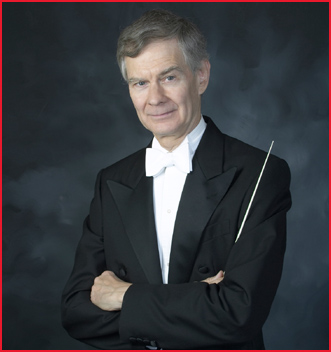NEP takes new-music clichés for a satirical spin in Hoffer’s “Three Pieces”

Richard Pittman led the New England Philharmonic in the world premiere of Bernard Hoffer’s “Three Pieces for Orchestra” Saturday night at Tsai Performance Center.
Best known for his television themes, Bernard Hoffer is also a symphonic composer who so abhors the clichés of contemporary classical music, he set out to parody them — which he’s done to gut-busting effect in his newest work, Three Pieces for Orchestra.
In this meta-symphony’s world premiere Saturday night at the Tsai Performance Center, the sendup of gestures beloved by many a young composer occupies the central movement, which got suitably flippant treatment from the New England Philharmonic and conductor Richard Pittman. String players used sliding fingers and sideways-turned bows to generate varieties of noise. Brasses supplied a veritable laugh track with wah-wah figures. A solo tuba sounded out robust blasts and mouthpiece buzzes. For any new-music partisans who might have misunderstood Hoffer’s intent, the movement’s title would have helped: “Mann Muss Lachen” (One Has to Laugh).
As the creator of assorted small-screen ditties — PBS’s MacNeil/Lehrer Report, the Rankin/Bass cartoons ThunderCats and SilverHawks — Hoffer, 83, knows how to lodge a hook in a listener’s brain in just a few bars. But New Englanders also know him for his lengthier symphonic works. The Philharmonic premiered his gleaming Violin Concerto in 2014 and — in an instance of Hoffer combining long form and short —recently performed his bold and attractive MacNeil/Lehrer Variations.
Three Pieces for Orchestra is a worthy addition to Hoffer’s catalog. The new-music parody is bracketed by colorful movements that aren’t meant as barbs. “Fog,” the first, is a shimmering, Debussyian collage where muted brasses seem to call from a distance and string figures coalesce in an attractive sheen of sound. The finale, “Movendo,” spins relentlessly, with references to orchestral tradition — quotations from Mendellsohn’s “Italian” Symphony and Beethoven’s Fifth — coursing through Hoffman’s own driving musical figures. The Philharmonic played it all with panache.
Saturday’s season-concluding program featured two additional premieres. David Rakowski’s Water, heard for the first time anywhere, and Sebastian Currier’s Time Machine, in its first Boston performance.
Water is the first movement to Rakowski’s Symphony No. 7, which the Philharmonic will premiere next season. On Saturday it was an ear-catching eight minutes, with music rendered in aqueous hues by Pittman and the Philharmonic: Figures trickled and flowed, recalling Debussy’s La Mer and the undulating harmonies of other impressionists. Strings passages in octaves evoked the frozen landscape of Vaughan Williams’s Sinfonia Antartica.
Colors and textures blend in unusual ways in Currier’s Time Machine, a 2007 work composed for Anne-Sophie Mutter that unfolds in seven short movements for solo violin and orchestra. Currier’s themes are fragmented, spliced together, layered upon one another, and, later, rendered in reverse. The composer’s harmonic writing is occasionally thorny, an aspect most apparent in the final movement, where unresolved dissonances hang in space.
In tones ranging from silvery to dusky, soloist Danielle Maddon tossed off Currier’s agitated lines without overdramatizing them or trying to oversell the larger work’s inherent turmoil. In the slow movements, her lines floated above the orchestra, while running figures in the middle movements took her to the very top of her range, her tone like faint light. Save for a few tentative attacks in the strings, the New England Philharmonic provided an energetic accompaniment.
Ravel’s Bolero closed the program, and to this marvel of orchestration the New England Philharmonic, for the most part, brought svelte phrasing. A few unfortunate cracks marred the bassoon solo, and the oboe d’amore melody wandered off key in its lower register. But throughout, the orchestra found the bracing intensity of this most famous of crescendos.
Posted in Performances





Posted May 06, 2018 at 3:47 pm by George Muller
HI I am the Bassoonist who had the unfortunate cracks in the Bolero Solo. after a long professional playing career I found a home with the NEP. I had never in over 30 years of my career played the Bolero solo, and it happened that the concert version was my best after botching just about every rehearsal. thank you for the kind words. I mean this sincerely.
The members of the NEP and Pittman have been very gracious to me